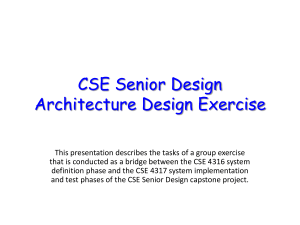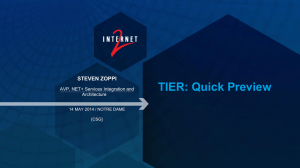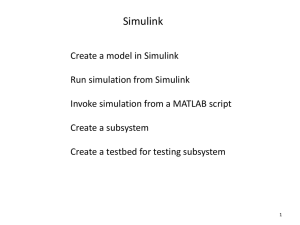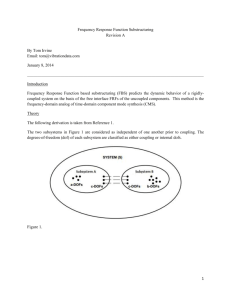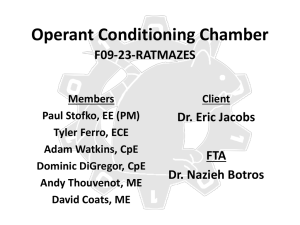Software Architecture - ECE
advertisement
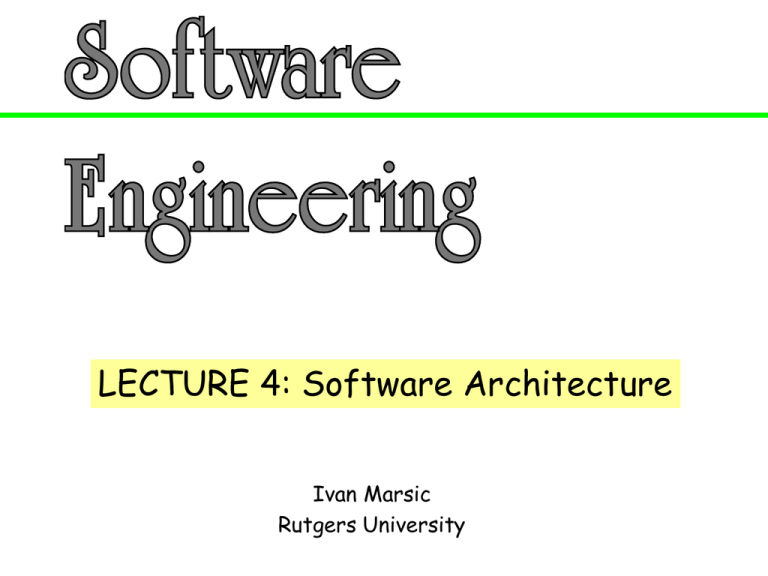
LECTURE 4: Software Architecture Ivan Marsic Rutgers University Topics • Software Architecture Definition • Architectural Decisions & Key Concerns • Problem Decomposition & Problem Architecture • Architectural Styles • Documenting Architecture: Views 2 Hierarchical Organization of Software Product line (or product family) highest abstraction level System or product Subsystems/Modules Packages Classes/Objects Methods lowest level Source code We know there are different views of abstraction in software … 3 Software Architecture Definition • Software Architecture = a set of high-level decisions that determine the key elements of the system-to-be and their relationships – Principal decisions made throughout the development and evolution of a software system – made early and affect large parts of the system (“design philosophy”) — such decisions are hard to modify later • Software Architecture is not a phase of development – Does not refer to a specific product of a particular phase of the development process (labeled “high-level design” or “product design”) 4 Example Architectural Decisions Safe Home Access System Subsystem for device control Subsystem for administration Subsystem for remote data access Decision on system decomposition On embedded computer On office desktop On tenant’s smartphone Decision on software-tohardware mapping Such decisions are made early on, perhaps while discussing the requirements with the customer to decide which hardware devices will be used for user interaction and device control 5 Architectural Decisions —A matter of scope product line architecture decisions product or system architecture decisions systemic impact Product line scope Product/system A scope Product B scope Subsystem scope Class scope local impact • Given the current level of system scope, a decision is “architectural” if it can be made only by considering the present scope – I.e. could not be made from a more narrowly-scoped, local perspective – Architectural decisions should focus on high impact, high priority areas 6 that are in strong alignment with the business strategy Software Architecture Key Concerns (Principal decisions to be made) • System decomposition – how do we break the system up into pieces? – do we have all the necessary pieces? – do the pieces fit together? • Cross-cutting concerns – broad-scoped qualities or properties of the system – tradeoffs among the qualities • Conceptual integrity 7 System Decomposition Product line (or product family) System or product Subsystems/Modules Packages Classes/Objects Methods The hierarchy shows a taxonomy of the system parts, but not the procedure for decomposing the system into parts — how do we do it? But, why do we want to decompose systems? 8 Why We Want To Decompose Systems • Tackle complexity by “divide and conquer” • See if some parts already exist & can be reused • Focus on creative parts and avoid reinventing the wheel • Support flexibility and future evolution by decoupling unrelated parts, so each can evolve separately (“separation of concerns”) • Create sustainable strategic advantage 9 Architecture versus Design • Architecture focuses on non-functional requirements (“cross-cutting concerns”) and decomposition of functional requirements • Design focuses on implementing the functional requirements – Note: The borders are not always sharp! 10 Architectural Decisions Often Involve Compromise • The “best” design for a component considered in isolation may not be chosen when components considered together or within a broader context • Plus, business priorities, available resources, core competences, target customers, competitors’ moves, technology trends, existing investments, backward compatibility, … 11 Decomposition: Projection vs. Partitioning (a) (b) 12 Problem Decomposition Subsystems derived from the requirements 13 Typical Software Eng. Problems 1.a) System transforms input document to output document 1. User works with computer system (environment irrelevant/ignored) IN doc System OUT doc 1.b) User edits information stored in a repository User System System Repository User 2. Computer system controls the environment (user not involved) System Environment 3. Computer system intermediates between the user and the environment 3.a) System observes the environment and displays information User User System Environment System Environment 3.b) System controls the environment as commanded by the user 14 User System Environment Problem Architecture 1.a) Transformation: Feeding subsystem Transformation subsystem Receiving subsystem Data editor 1.b) Simple workpieces: User Data repository 2. Required behavior: Controlling subsystem Controlled subsystem 3.a) Information display: Monitoring subsystem Monitored subsystem Controlling subsystem Controlled subsystem Display 3.b) Commanded behavior: Operator 15 Architectural Styles • World Wide Web architectural style: REST (Representational State Transfer) • UNIX shell script architectural style: Pipe-and-Filter • Client/Server • Central Repository (database) • Layered (or Multi-Tiered) • Peer-to-Peer • Model-View-Controller 16 Architectural Styles – Constituent Parts 1. Components – Processing elements that “do the work” 2. Connectors – Enable communication among components • Broadcast Bus, Middleware-enabled, implicit (events), explicit (procedure calls, ORBs, explicit communications bus) … 3. Interfaces – Connection points on components and connectors • define where data may flow in and out of the components/connectors 4. Configurations – Arrangements of components and connectors that form an architecture 17 Architectural Style: Pipe-and-Filter • Components: Filters transform input into output • Connectors: Pipe data streams • Example: UNIX shell commands filter filter pipe % ls folder-name filter pipe | grep –v match-string | more 18 Architectural Style: Layered a.k.a. Tiered Software Architecture User Interaction User Interface Layer User Authentication Archiving Control of Sensors and Devices Communicating alerts about intrusion Domain Logic Layer (Business Rules) Technical Services Layer 19 Architectural Style: Model-View-Controller Model: holds all the data, state and application logic. Oblivious to the View and Controller. Provides API to retrieve state and send notifications of state changes to “observer” View: gives you a presentation of the Model. Gets data directly from the Model Controller: Takes user input and figures out what it means to the Model display 5. I need your state (to display) View 4. I have changed 3. Change your display Model 1. The user did something user Controller input device 2. Change your state 20 Model-View-Controller User Interface Model Controller Input device events User Visual feedback of the altered model Event Interpreter Domain model action Model Visualizer Notification about the effects of the action View Model: array of numbers [ 14, 26, 31 ] 26 14 Different Views for the same Model: Domain Model 31 14 versus 31 26 21 Real System is a Combination of Styles Subsystem for device control Central Repository Subsystem for remote data access Subsystem for administration - Valid keys - Access history - Tenant profiles -… Application server Web server Web browser 22 Fitting the Parts Together • Interface Specification Semantics – To serve as a contract between component providers and clients, interfaces must be – fully documented – semantics, not just syntax – understandable, unambiguous, precise • Adding semantics – informal description – design models (e.g., UML interaction diagrams) – pre/post conditions 23 Documenting Software Architecture: Architecture Views • Views are different kinds of “blueprints” created for the system-to-be • E.g., blueprints for buildings: construction, plumbing, electric wiring , heating, air conditioning, … (Different stakeholders have different information needs) 1. Module/Subsystem Views 2. Component and Connector Views 3. Allocation Views 24 Module/Subsystem Views • Decomposition View – Top-down refinement (e.g., simple “block diagram”) • Dependency View – How parts relate to one another • Layered View – Special case of dependency view • Class View – “domain model” in OOA and “class diagram” in OOD 25 Component and Connector Views • Process View – Defined sequence of activities? System represented as a series of communicating processes • Concurrency View • Shared Data View – … • Client/Server View – E.g., in Web browsing 26 Allocation Views • Deployment View – Software-to-hardware assignment • Implementation View – File/folder structure – “package diagram” • Work Assignment View – Work distribution within the development team 27




